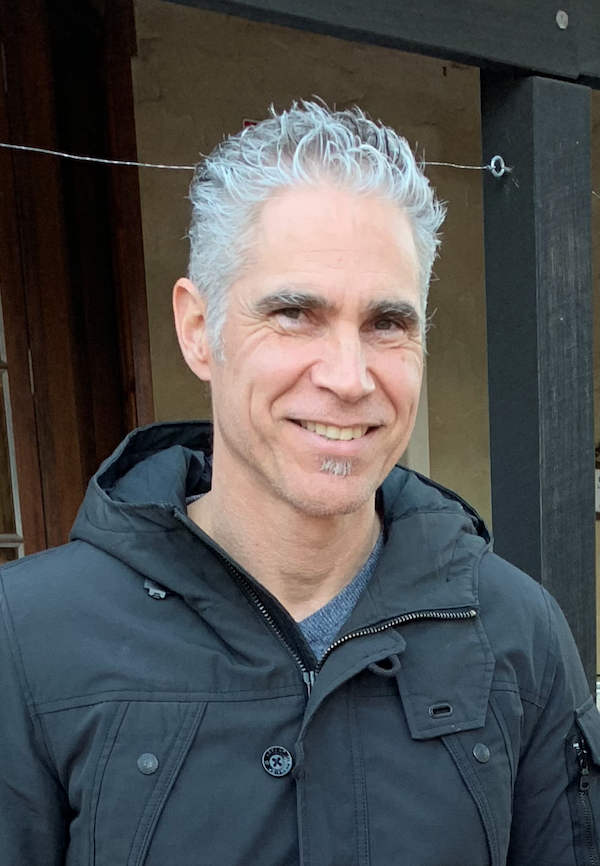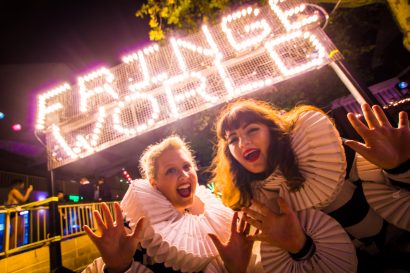As a son of a member of the Stolen Generation, Dunsborough-based artist Christopher Pease didn’t know much about his Aboriginal heritage when he was a child.
Now he has created a series of works that explore Aboriginal identity and culture, one of which has been selected as a finalist in the Telstra National Aboriginal and Torres Strait Islander Arts Awards. Jaimi Wright spoke to Christopher Pease to find out more.

In testament to his name, Christopher Pease exudes an easy kind of warmth. As he describes his striking artwork Kartwarra (2019, pictured top), he admits that entering a work in the 2019 Telstra National Aboriginal and Torres Strait Islander Art Awards (NATSIAA) had not initially crossed his mind. Now the Dunsborough artist is a finalist in the prestigious competition, with Kartwarra, a poignant work that is a complex study of contemporary Aboriginal identity and heritage.
Kartwarra is not intended to be a comfortable viewing experience. The work is part of the larger, four year long, six work series “Minang Boodjar”, the premise of which is taken from a series of colonial sketches of King George’s Sound by English Lieutenant Robert Dale in the 1830s. Overlaid on Pease’s interpretation of Dale’s work are three ominous geometric shapes; a grim reminder of Dale’s connection to King George’s Sound and local Indigenous heritage. The shapes are based on a print of the head of Nyoongar leader Yagan, taken back to England by Dale to serve as a local curiosity. There is a tension in the macabre juxtaposition of Dale’s print and Pease’s contemporary deconstruction of Yagan’s head. It is these tensions and juxtapositions that speak of Pease’s experience of identity.
A combination of English, French and Minang/Nyoongar descent, Pease had no active relationship with his Aboriginal cultural heritage growing up. “I knew that I was Aboriginal, but I didn’t know my family ties or traditional language,” he remembers. “It wasn’t until maybe year nine or ten that I started [to be curious about it].”
Police forcibly took Pease’s mother away from her family at an early age and she was raised in the infamous Sister Kate’s boarding school, established in Perth. A member of the Stolen Generation, she didn’t reunite with her family until her late thirties, when Pease was in high school. This separation created a cultural disconnect, one that Pease bridged visually in the process of creating “Minang Boodjar” years later.
“What started it all was, I guess, back in 1999; I was trying to find a visual iconography that has very old roots,” he explains. “I wanted to revive the Nyoongar visual iconography.”
What ensued was a search through museums and photographs searching for Nyoongar iconography. This trail led Pease to a series of photographs by controversial nineteenth-century Irish anthropologist Daisy Bates and, eventually, to Robert Dale’s print of King George’s Sound.
“There’s always questions as to the accuracy and how much propaganda is in the old artwork,” he reflects. “I think it’s a mixture of a lot of things. There are a lot of truths in it, but also a lot of propaganda in the old prints.”
Kartwarra questions the accuracy of this mixture, but is not overly didactic in doing so. Though the work addresses heavy subject matter, its abstract elements posit themes rather than direct ideas. At its core, Kartwarra is an exploration of connections; between objects and history, between cultural interpretations, between a man and his heritage.
Although Pease laughs to himself as he admits he only entered NATSIAA after a request from a friend, he says he is grateful to be one of the 68 artists to be finalists in Australia’s longest running and most prestigious Indigenous art award. “The standard is very high, I’m glad to be a part of it. The work up there is always at an amazing level.”
Kartwarra makes for powerful viewing. With tactful curiosity the artwork addresses issues of shifting contemporary and Aboriginal and European identity, both on a personal note and now on a national level.
The winners of the 36th Telstra NATSIAA Awards will be announced at an awards ceremony at Museum And Art Gallery Northern Territory’s Bullocky Point Facility on Friday 9 August 2019.
The exhibition of the finalists’ works will be on display at MAGNT from 10 August – 3 November.
Pictured top is Christopher Pease’s ‘Kartwarra’, 2019, oil and Balga resin on canvas, 36th Telstra NATSIAA. Courtesy of the artist and Gallerysmith.
Like what you're reading? Support Seesaw.






